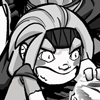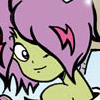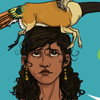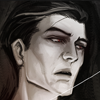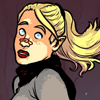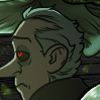Category Archives: motion comic
The Webcomic Overlook #235: Hobo Lobo of Hamelin

Ladies and gentlemen: how do we know we’re in the future? Is it when we get flying cars? Is it when we can replace our arms with cyborg parts? If comic pundits will have you believe, it’s when webcomics realize their full potential and embrace the infinite canvas. No more being restrained to the rigid static confines of a piece of paper, developed hundreds of years ago! Why live within those archaic limitations? We’re living in the future, son!
And just like how flying cars and prosthetic limbs exist in real life, so too are there examples of these futuristic comics. Some do nothing more than scroll in one direction for a long time. Others contain significantly more bells and whistles by incorporating sound and simple animation.
A relatively recent effort is Stevan Živadinović’s Hobo Lobo of Hamelin. And by “relatively recent,” I mean that it began in 2011 and was updated as recently as September 2013. I actually mentioned this comic when it first came out and had hoped to review it when more became available. It looks like not much progress has been made in the intervening two-and-a-half years, though. Note to pundits who still lean on the “motion comic” approach to webcomics: if you’re doing one by your lonesome, they’re a massive time sink.
The Webcomic Overlook #231: MS Paint Adventures: Homestuck (Acts 1-4)

I’m baaacccckkkk!
It’s time once again to delve into the world of comics in the digital medium, where your eyes are bombarded not by inks and tree fibers but rather by the warm, embracing glow of an LCD monitor. There’s been a pretty big gap in my reviewing back catalogue, which for some reason includes something called Loviathan and something called Glam but for some reason doesn’t include the webcomic whose cosplayers overtook Emerald City Comic Con this year.
That’s right, readers: it’s time for yet another review of Andrew Hussie’s MS Paint Adventures: Homestuck!
Now, for those of you who are unfamiliar with Homestuck, or maybe you’ve heard about it in bits and pieces but really don’t know much about it, there’s one thing you should know right off the bat: it’s a very long webcomic. A VERY long webcomic. And deceptively so. As a result, I’m splitting this review into two segments. The first will reivew Acts 1-4, which focused mainly on the players of John, Rose, Dave, and Jade. (I will call these four “Pesterchums.” I don’t know if that’s the official term for them, but that’s how they appear categorized in their chatlogs.) The second will deal with Acts 5 and beyond, which seems to focus on the trolls.
Is this a fair dividing point? I think so. Back in the day (holy crap, this comic started back in 2009?) fans on the webcomic seemed to be split on how to take Act 5. The focus one trolls cause some to quit. On the other hand, trolls seems to be what maneuvered Homestuck to the big leagues. How much fan art is devoted to trolls vs. that which is devoted to the original crew? I’m guessing a million to one. As a result, my scholarlycomparison of trollspeak to Li’l Abner‘s cornpone dialects is going to have to wait until Part 2. Doesn’t that sound exciting?
… yeah, I didn’t think so either.
Random Quickies: Thunderpaw
As a relative newcomer to Tumblr, I have only lately come to a surprising realization: animated gifs are everywhere. Like, on every single blog that has “F*** Yeah” as the title. They are back in a bigger way than when that dancing CGI baby was all the rage. (Readers under 20, please disregard this horribly dated reference.) I’ve also noticed that seeing a bunch of animated gifs in a row, usually recapping a segment on TV, is not unlike reading a comic.
So it should come no surprise that there are some webcomics out there following suit. Jen’s Thunderpaw follows two anthropomorphic friends, Bruno and Ollie, as they go on a journey that seems to fracture their very mental state. During the comic, looped animated panels make everything jittery and haunting. I can’t say Thunderpaw makes sense, exactly, but it’s long on environment and is pretty to look at.
(h/t to reader gosicht)
The Webcomic Overlook #164: The Boy With Nails For Eyes

A small part of me is fascinated by motion comics. Their creators face an uphill battle that stem from the limitations of the interface. Motion comics exist in that strange netherworld between static comics and animation. They are eye-catching, admittedly. And they attract a lot of attention. Several pundits seem to think that motion comics are what a webcomic should strive to be, unencumbered as they from the static limitations of a page and expanding artistically into realms unknown and embracing the liberating tools available to all that use HTML, Flash, Java, XML, etc.
However, there are drawbacks. Most readers are familiar with them. They are issues that bring into question the definition of “comics”. Unlike with traditional comics, the reader of a motion comic has little to no control over the pacing. When reading a motion comic, the flow becomes intermittently interrupted. You tend to cruise along for segments at a time when suddenly you come to a complete stop. There’s a second or two where you hesitate until you click the prompt to continue. Why is this such a big issue? After all, you still click on the “page forward” link as a reader of a traditional webcomic. However, the action becomes such an integral part of the experience that it become barely noticeable. When watching a cartoon, you don’t click anything at all. But when you’re forced to switch between the two modes, you tend to get self-aware for a moment. The jarring transition between hands-free animation and hands-on comic tends to yank me out of a story.
Yet, there are a lot of motion comics that I do like. Nawlz, for instance, which I gave a positive review here. I think one of the biggest reasons that Nawlz works is how natural the controls felt. Cut scenes didn’t feel overly long. Scene transitions weren’t alienating. You retained the sense of control over the dimension of time, one of the key elements that separate comics from movies and videos.
Not too long ago, Shaun Gardiner sent me a request some time ago to check out his motion comic, The Boy With Nails For Eyes. While he’s currently a resident of the UK, he lived in the Middle East until he was 15. During that time, the first Gulf War broke out. While The Boy With Nails For Eyes can be intentionally esoteric, several elements strike me as autobiographical.

The Webcomic Overlook #126: Wendy Pini’s Masque of the Red Death

I became a comic fan in the early 90’s during the debut of Jim Lee’s X-Men. Thanks to my nerdy, obsessive nature, I ended up taking a strong interest in the history of comics. I used to hope up at the Detroit Public Library, head up the stairs to the second floor (which had some fantastic Diego Rivera murals that I didn’t appreciate at the time), and pored through various books about comic book history. I learned about obscure, now-forgotten heroes, reveled in pages devoted to Will Eisner’s The Spirit, and took a passing interest in the Kitchen Sink Comix movement of the 1970’s.
When the book got to the 80’s, a couple of names stood out prominently: the husband and wife team Wendy and Richard Pini. Their comic, Elfquest, was the standard bearer for indie comics of the 1980’s. It was THE sterling and unassailable example that creators didn’t need to sell their souls to the Big Two to create a comic book hit.
However, I never got into Elfquest much. I tried reading the books, which were also available in hardcover at the library, but they weren’t for me. I think the books were successful because they pursued the female comic reader market before manga proved to everyone that they were commercial viable. While a noble pursuit, these delicate fantasy comics filled with dewy-eyed pretty boys were definitely not for me, who longed for nothing more than to read page after page of muscly guys punching each other.

Still, I was filled with giddy excitement when, one day while browsing through the “webcomic” entry of Wikipedia, I ran across Wendy Pini’s name attached to an online adaptation of Edgar Allan Poe’s The Masque of the Red Death. Ah, I thought, the perfect gateway into the world of Wendy Pini! I loved Poe’s original short story, and I was excited to see how that would translate to comics.
Imagine my surprise when the webcomic bore less resemblance to Poe’s Masque of the Red Death and more similarities to Anne Rice’s The Claiming of Sleeping Beauty. That is to say that Rice, writing under the name A.N. Roquelaure, mainly used a well known story as a framework for erotic literature about bondage, domination, and sadomasochism.
In case it hadn’t bee quite clear to you yet, Wendy Pini’s Masque of the Red Death is similarly and adults-only affair. The review itself doesn’t really go overboard into NSFW territory, but, still, proceed at your own caution.

The Webcomic Overlook #124: MS Paint Adventures: Problem Sleuth

NOTE: A commenter has pointed out that MS Paint Adventures isn’t actually done in MS Paint. This manages to invalidate about 5 or 6 paragraphs in this review. So please treat these paragraphs as the ravings of a lunatic. Thank you.
MSPaint has been around since Windows 1.0. when it was called PC Paintbrush. It’s a piece of software that has since been bundled into every version of the Windows OS. Thus, it’s the only graphics painting program that everyone has. It’s simple to use with a few features. Airbrush, paintbrush, line, curve, and ellipse are all you have. Colors are limited to 48 selections.
In other words, it’s very very limited. It’s probably something you don’t want to use if you’re creating a webcomic. When you think MS Paint, you think of, oh, Pokey the Penguin. The joke, more often then not, is the awfulness of the graphics. If you want to actually create art, you’re probably better off using a more versatile software.
Or so you’d think. I’ve seen some surprising attempts at art online. Wikipedia, in fact, boasts a few nicely rendered examples. The result is quite impressive since most computer users are already familiar with the effort it takes just to draw a simple stick figure.
Pushing the envelope is Andrew Hussie, who must have a Master’s Degree in Maximizing Bundled Microsoft Programs for Humor Projects. Hussie is co-creator of a series of Star Trek: TNG and ALF edits, and he redefined the art of making deliberately terrible webcomics with Sweet Bro & Hella Jeff. He’s best known, though, for his efforts on a little thing called MS Paint Adventures.
His latest MS Paint Adventures project, Homestuck, is one of the most visually impressive uses of MS Paint I’ve ever seen. However, I decided to check out his first completed work in MS Paint (and the one that really put MS Paint Adventures on the map), the adventure game parody known as Problem Sleuth. It’s an absolute monster, clocking in at over 1700 pages. And yet it’s the easier than Homestruck to get into.
Crabcake Confidential: The Prisoner Online Graphic Novel

I’ve got a pretty embarrassing confession to make: I was pretty damn excited when AMC started airing commercials of The Prisoner remake. I told everyone within earshot about it. “Man, are you going to be watching Prisoner?” I’d say. “It looks totally sweet! Watch it watch it watch it!” I planned my weekend around watching it, even flipping channels from a riveting Patriots-Colts match-up on Sunday Night Football. The special effects looked slick, and changing the setting from an island to a desert not only looked scenic, but also opened up the possibility of new twists to the original. Plus it starred Jim Caviezel and Ian McKellen. You heard that right: Ian Friggin’ McKellen. The man who made Gandalf the Grey a believable parable for the Civil Rights Movement. There’s no WAY this was anything but must see TV!
And I’m not even that huge of a Prisoner fan. I’d only seen three episodes beforehand: “Arrival,” “The Chimes of Big Ben”, and the ridiculously trippy finale “Fall Out.” Plus I was indoctrinated by all “The Prisoner” pop culture references, mainly the infamous Simpsons episode where Homer ends up on … The Island. (“Why a balloon?” “Shut up! That’s why!”) There’s so much potential in a remake: perhaps we could get new, fresh resolutions to a lot of the unanswered questions in the original!
So I watched the remake and … well.. in the words of MST3K‘s The Mads: “Sandstorm. Saaaaaannnnndddstoooorrrmmmm. Deeeeeep Hurrrttttiiinnnggg.”
In the first two episodes, you get maybe 5 minutes of awesomeness (any appearance of Rover and most of Ian McKellan’s scenes) and 120 minutes of moping, “surreal” imagery that really wasn’t all that weird, and uninteresting secondary characters. I tried to like this remake. By God, did I ever try. Even after my initial disappointment, I tuned in to the conclusion on Wednesday, just to see how what the AMC series would tie it all together. I fell asleep only about 10 minutes in. Does Jim Caviezel dance to “Dem Bones” while robed judges in half-black, half-white masks cheer on? I have no idea. The Wikipedia plot summary doesn’t give me much hope, though, because the secret behind The Village sounds LAME AS ALL HELL.
At the same time, AMC launched a webcomic — I’m sorry, “online graphic novel” — to expand on The Prisoner mythos. It can be found here at the AMC site. Now, given that I hated, hated, HATED AMC’s The Prisoner, you’ve got to ask yourself: why in the world would I ever even bother to read The Prisoner webcomic? Well, I was partly driven by due dilligence and partly driven by morbid curiosity. I also held a small, irrational glimmer of hope, too, that there might be a chance The Prisoner webcomic could surpass the TV show as the standard bearer for the modern day Prisoner canon.
The Webcomic Overlook #64: Nawlz

I realize that I’m probably going to alienate a huge portion of my readers here, but I find xkcd to a rather hit-and-miss comic. This is coming from someone who has an engineering degree. (The again, as Sheldon from The Big Bang Theory says, “Engineering is merely the slow younger brother of physics.”)
However, I will point out that there are times when Randall Monroe is on the money. Take for example, this toon plotting the Probability the Book is Good vs. Number of Words Made up By Author which specifically targets cyberpunk author Neal Stephenson. It works because Monroe is on the money: the propensity for silly-sounding techno-terms in cyberpunk novels is pretty damn embarrassing.
I will concede that there’s at least one good reason why Cory Doctorow, William Gibson, or, hell, the Shadowrun series writers indulge in such tortured gobbledy-gook. If you don’t spend too much time over-analyzing the meanings of each abbreviation and slang term, the odd cadence puts you into a trance, more or less. There is a point when things become unknowable, and you, the reader, sort of accept it. The words are akin to Latin spoken in a pre-Vatican II liturgy, generating the enchantment of a magic spell, only rooted in the future rather than in the past. What I’m saying is that cyberpunk is a quasi-religious experience. Quite bizarre, when you think about it: cyberpunk is often surrounded in nihilistic, godless trappings, yet technology itself tend to take the unexplainable form of a mysterious deity.
I find it strange that, in my some two years of reading and reviewing webcomics, I haven’t come across many examples of cyberpunk comics. Sure, there’s plenty of zombie apocalypse comics, steampunk comics, and space opera comics. But cyberpunk? And when one such comic eventually did cross my path, I found myself a little hesitant to even call it a webcomic … that innocuous term suddenly sounding limiting and restrictive.
The comic, Nawlz, is written by Sutu, who’s real name is Stu Campbell and who hails from Australia. The Nice Produce blog says that he’s design HUDs for military applications. While this might be turn out to be nothing more than an irrelevant piece of trivia, I feel it helps me understand Nawlz‘s unique take on storytelling.






















